Search the Special Collections and Archives Portal
Search Results
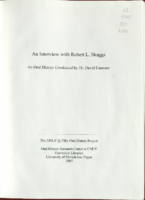
Transcript of interview with Robert L. Skaggs by Dr. David Emerson, May 06, 2006
Date
2006-05-06
Archival Collection
Description
Dr. Robert Skaggs grew up around the St. Louis area. His father was a teamster with a milk delivery route, tried his hand at the restaurant business, and during WWII worked tor U.S. Cartridge. Several members of Dr. Skaggs's family were teachers, including his grandmother and a couple of aunts. Robert graduated trom Normandy High School and afterwards attended the Missouri School of Mines and majored in metallurgical engineering. He graduated in 1954 and went to work tor DuPont tor two years. He went to graduate school at Iowa State on an Atomic Energy Commission scholarship, and afterwards was hired by Standard Oil of California. During this time he met and married Anna Pedersen (1961) and moved to Minneapolis to work for Honeywell. Around 1966, Bob started teaching at the University of Kentucky. After a couple of years, he got wind of teaching opportunities at the Southern Division of the University of Nevada (now UNLV), and interviewed with Herb Wells. He and his family moved to Boulder City (1969) and he began teaching at what is now UNLV. He was involved in the work bringing accreditation to the engineering department, establishing a chapter for Tau Beta Pi, the Engineering Honor Society, and building a master's and a PhD program. After a heart attack in 1975, Dr. Skaggs took a sabbatical from UNLV and did some team teaching at University of Arizona in Tucson with Ray Sierka. He returned to UNLV on a half time teaching basis, and also worked for the Bureau of Mines. He was again involved in accreditation preparations and stayed to graduate a PhD student in engineering. He looks upon his experiences at UNLV as very positive and delightful.
Text
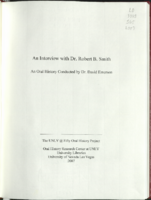
Transcript of interview with Dr. Robert B. Smith by Dr. David Emerson, June 13, 2006
Date
2006-06-13
Archival Collection
Description
Dr. Robert Bruce Smith was born in Philadelphia and spent his first two years in New Jersey, but thinks of California as home. His father's calling as a minister had taken them back east, and after his seminary training they returned to Los Angeles, followed by a five year stint in Oregon before returning to Vista, California. After high school graduation, Bob left home to attend Wheaton College in Illinois, a small Protestant school. He met his wife there and after completing his Bachelor's in chemistry they were off to Berkeley, where he completed his PhD in three years. Along the way, Dr. Smith had worked for G.D. Searle in Skokie, Illinois, and at first thought that this was his calling. His semester as a Teaching Assistant, however, convinced him that the academic life was what he wanted. Late in 1961, he learned of a job opening at the Southern Regional Division of the University of Nevada (now UNLV), interviewed with Malcolm Graham who was recruiting in San Francisco, and flew to Las Vegas to see the campus for himself. It consisted of three and a half buildings surrounded by desert. Robert's thesis director encouraged him to take the job at this new, very small college, so he and his wife drove to Las Vegas to find an apartment. They fell in love with the area and he started at UNLV as assistant professor of chemistry. He did work in organic chemistry and served as chair of the Department of Physical Sciences, as it was then called. In 1968 the department was turned into a college, and Bob became the dean of the College of Science and Mathematics. He held this position for 12 years. In 1980, Dr. Smith accepted an offer from Weber State College in Ogden, Utah, and served there as Academic Vice President (later Provost) until his retirement in 1998. He recalls with great clarity the people, changes, and events that he was involved with during the early years at UNLV. Today he and his wife enjoy their retirement in their favorite spot in the San Jacinto Mountains.
Text
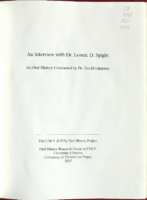
Transcript of interview with Dr. Lonnie D. Spight by Dr. David Emerson, May 8, 2007
Date
2007-05-08
Archival Collection
Description
Dr. Lonnie D. Spight grew up in northern Colorado, earned his bachelor's degree at Colorado State University, and his PhD at University of Nevada Reno. His interest in astronomy dates from his early years on the farm in Colorado, star-gazing in the fields at night. Before coming to UNLV, Lonnie worked for the Department of Defense on scattering cross sections and explosions. Working between Los Alamos and the Test Site, he was often in Las Vegas and had met most of the physicists at the university. He was invited midterm to take over a physics class for a faculty member who had fallen ill, and was offered a job the following fall of 1970. In the seventies when Dr. Spight arrived, the physics department was located in trailers, and the university campus was mostly desert. Lonnie served as chair of the department on several occasions, and was responsible for insisting that faculty members get involved in research, no matter how tight the budget. He worked on solar energy and far-field microwave analysis, and helped set up safety standards for the new laser technology. One of Dr. Spight's interests outside of physics is a love for classical music. He was a volunteer "Deejay" for 12 years with KNPR once it got started in 1980. Meanwhile, after 37 years with UNLV Lonnie retains his enthusiasm and love for teaching. Today he teaches quantum mechanics and hopes that one day he will be able to teach a particle physics course which ties together cosmology, the beginning of the universe, fundamental cutting edge physics, quarks, gluon plasmas, and more. He has the course materials ready to go and is looking forward to many more years at UNLV.
Text
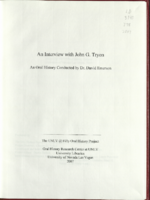
Transcript of interview with John G. Tryon by Dr. David Emerson, February 21, 2006
Date
2006-02-21
Archival Collection
Description
John G. Tryon was one of the early leading figures in the Engineering Department at UNLV. He grew up in Washington, D.C., the oldest of three sons. His father worked with the National Bituminous Coal Commission during the Depression and his mother was editor of the American Association of University Women's Publications. John went directly to University of Minnesota after high school graduation and earned a bachelor's in physics. During WWII he served in the Army Signal Corps and then went back to Cornell University to get his doctorate. His post doctoral work experience includes six years at Bell Telephone Laboratories, eleven years at University of Alaska, and six years at Tuskegee Institute. In 1974, Dr. Tryon interviewed at UNLV and was hired. The faculty carefully built up the curriculum, adding classes one at a time. John introduced a senior engineering design course modeled after one that pioneered at Dartmouth. He had also introduced this particular course at University of Alaska and Tuskegee. John was a member of the Academic Standards Committee at UNLV which helped set standards for academic probation and semester length. He has strong opinions on keeping engineering students who show promise and interest, and letting go of students whose academic strengths don't match the program. He believes students need to be matched to opportunity, be given the chance to find a niche that fits, and that they should not be given inflated grades or false hope. Dr. Tryon met his wife-to-be in Ithaca, New York, while attending Cornell University. His wife's mother, who was married to a botany professor, had invited him to Sunday dinner, something she had done for a number of students. John and his wife, who eventually became an English teacher, have two sons who grew to college age while they were in Alaska. Today they enjoy their church community, their family, and their circle of friends.
Text

Transcript of interview with Jerome "Jerry" Jay Vallen by Lisa Gioia-Acres, October 2, 2007
Date
2007-10-02
Archival Collection
Description
Jerome Jerry Jay Vallen was born and grew up in Philadelphia, Pennsylvania. His father was in the restaurant business and Jerry worked for him throughout his teens and young adulthood. He and his two brothers entertained themselves during their childhood years by going to the library and reading. This was a legacy of the Depression era, when there simply wasn't any money to spare for extraneous expenses. Jerry's first jobs were bellman / assistant manager in a small hotel; auditor, and then property manager at the Pine Tree Point Club. He attended Penn State for a year (working in his dad s restaurant the whole time) and then transferred to the hotel school at Cornell University. After a stint in the armed forces during the Korean War, he returned home and used the GI bill to finish his master's degree. He started on his doctorate, but it would be 20 years before he completed it. After getting married (1950) and starting a family, Jerry and his wife Flossie realized that the restaurant business and family life did not mix well, so he decided to stay in education. Fie spent several summers at the University of Pennsylvania in their graduate school of business and in 1966, interviewed with Jerry Crawford, provost at UNLV. Jerry and his family moved out to Las Vegas in June of 1967, leaving northern New York during a blizzard and arriving four days later in southern Nevada to find tulips blooming. They decided they liked Las Vegas, found a house right away, and settled in to their new life. Jerry taught marketing in the hotel college at the beginning of his career and for several years thereafter. Boyce Phillips took the rooms division and George Bussel taught foods. Their main focus was to attract students, and they worked on making it easier tor students to transfer from out of state. Jerry also thought it was extremely important that the hotel college be independent of university administration control. Dr. Vallen has 5 or 6 books published, including 3 textbooks that he continues to update, and an oral history of the hotel college completed shortly after he retired in 1989. Today he and his wife travel and enjoy twice yearly gatherings with their family.
Text
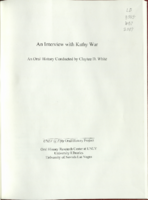
Transcript of interview with Kathy War by Claytee D. White, February 26, 2009
Date
2009-02-26
Archival Collection
Description
Kathy War fondly remembers being raised and educated in Helena, Montana. She and her husband Tom married in 1968 during an uncertain job market. After a short time in Seattle, they came to Las Vegas in 1970. Kathy drew upon her library work experience to apply for a job with UNLV's library. For the next four-and a half years she worked in the Curriculum Materials Library (CML). She then worked in the Inter-Library loan department and eventually moved to Special Collections. As she prepared to retire, she spoke of the growth that had transpired in Special Collections from three positions to ten. She describes the process of archiving over 60,00 photos and mentions the Oral History Research Center as important accomplishments of that department.
Text

Transcript of interview with Herbert C. Wells by Dr. David Emerson, March 8, 2006
Date
2006-03-08
Archival Collection
Description
Herbert C. Wells is currently professor emeritus of civil and environmental engineering at UNLV, and is considered the father of engineering at the university. He was born in Omaha, Nebraska, in 1927, and spent the first four years of his life there. After his father was killed in a plane crash in 1931, his mother moved them out to Los Angeles to be near her husband's parents. They moved several times, but the goal was always to find good schools for Herb and his sister Herb received an outstanding junior high education at Trailfinders School for Boys, and then attended Woodrow Wilson Junior High School in ninth grade. He then was sent to the San Diego Army Navy Academy, where he completed high school in two years and graduated at age 16. He next enrolled at Pasadena Junior College, majoring first in chemistry and then in geology, and was drafted into the army at age 18. After the war, Herbert returned to Berkeley to finish his education. The GI bill helped him finish his master's degree. He then went to work for United Geophysical for two years, and following that, was hired at a mine in Climax, Colorado. He and his second wife moved to Las Vegas in 1957, where he began working for Titanium Metals. After a mere three weeks on the job, he met with Dr. Malcolm Graham from early UNLV, who asked Herb to teach surveying. Dr. Wells taught surveying for only one semester, but continued his association with the faculty at the university. He kept working at Titanium Metals, where he learned a lot of practical chemistry, but was laid off shortly thereafter. He then was offered a job with Blue Diamond Gypsum as a plant engineer and continued teaching on a part-time basis. He became a full-time instructor at the college in 1961. By 1967, Herbert had been appointed chairman of science, math, and engineering. He immediately put in a request for ten more teaching positions, which were ultimately filled. He also was instrumental in putting together a proposal for a graduate degree in physics, and of course was involved in ABET accreditation for engineering degrees.
Text
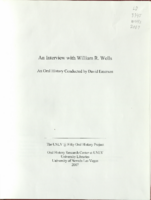
Transcript of interview with William R. Wells by David Emerson, May 22, 2006
Date
2006-05-22
Archival Collection
Description
Dr. William R. Wells was the first dean of engineering at UNLV. He was born in Winder, Georgia, and graduated from high school there. He attended Georgia Tech and then took a job with NASA in Virginia, where he also received a master's degree from Virginia Tech. He then went to Harvard for an MA degree, and ended up at Virginia Tech, earning a PhD in aerospace engineering. Dr. Wells had an impressive twenty-year work history in Ohio and Illinois before coming to UNLV in 1986. He came in on the ground floor of the newly endowed college of engineering and saw the college through several rounds of accreditation with ABET. He remembers the small student body and how easy it was for faculty members to interact with them. He also recalls that several local and state entities contributed money to the engineering program or hired graduates. As dean of the College of Engineering, Dr. Wells was involved in 'growing' the various departments. He has seen most of them develop masters and PhD programs, and remembers recruiting for new teaching positions. He also recalls moving into the new building in 1988. Accreditation was of major importance in the development of a significant and nationally recognized engineering college at UNLV, and Dr. Wells has his opinions as to its impact on creativity. He does believe that it is a necessary part of developing excellence and accountability to the community, the students and faculty, and the state. Dr. Wells talks about recruiting, faculty turnover, and salaries. He gives his opinions on using UNLV engineers for stage and set designs on the Strip, hiring graduates at local utilities, and helping students with deficient math or science skills. He also talks about attracting minority groups to engineering, diversity among the faculty, and the importance of keeping talent in the United States.
Text
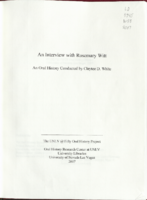
Transcript of interview with Rosemary Witt by Claytee D. White, November 7, 2006
Date
2006-11-07
Archival Collection
Description
Rosemary Witt grew up in the very small town of Columbia, Iowa. She went to a two-room country school in Columbia and attended high school in Knoxville. Her nursing diploma was completed at Iowa Methodist Hospital in Des Moines. She then worked in the operating room for a month or two and switched to pediatrics. When Rosemary's dad fell ill, she moved back to Knoxville to be closer to him and found employment at the VA psychiatric hospital. After five years there, first as staff and then as head nurse, she got the opportunity to attend a nursing program at the University of Iowa which paid tuition and a stipend. She completed her baccalaureate degree, and then worked as an assistant instructor. In the late '60s, Rosemary decided to further her education, and went to the University of Washington in Seattle for her master's in psychiatric nursing. She stayed for three years afterwards to teach on that faculty, and then attended a workshop in Las Vegas in 1971. Rosemary was attracted by the sunshine in Las Vegas, and called UNLV to see if there were any openings. She interviewed and was hired as a psychiatric nurse instructor. In '75 or '76, she decided to pursue her doctorate at the University of Texas in Austin, and persuaded her sister to move to Las Vegas to watch her house and pets while she was away at school. In the many years that she's been at UNLV, Rosemary had served as chair of the nursing program for over thirty of those years. She also served as interim director for a year while a search was conducted for a dean. Today she teaches classes and is involved in research. Rosemary recalls the early days when several disciplines were housed in Frazier Hall. Having spent over thirty years at UNLV, she has seen many changes in the campus and in the city. Today the nursing program has its own school and inhabits most of a large building. She and other instructors are involved in research which improves life for Las Vegans and patients everywhere. She is confident that the nursing school will continue to grow and offer more educational opportunities for students.
Text
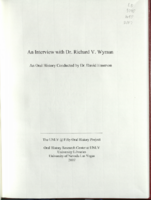
Transcript of interview with Dr. Richard V. Wyman by Dr. David Emerson, February 27, 2006
Date
2006-02-27
Archival Collection
Description
Dr. Richard V. Wyman was born in Painesville, Ohio, and lived there until he joined the navy in 1943 at the age of 17. His father got into real estate and insurance in Painesville. Richard's mother graduated from Ohio State with a degree in home economics, worked until she married, and then devoted her life to her family. In high school, Dick took college prep classes. A month before he graduated he joined the Navy and was sent to college part of the time. He got out of the Navy in 1946 and continued on in college with help from the 52-20 club, a type of GI bill. He studied geology in the night school division of Western Reserve. He met his future wife Anne during this time and they were both admitted to Michigan State grad school. After graduate school, Richard and his wife moved to South America where he had been offered a job. His wife eventually taught grade school there, K through 8. They moved back to Prescott, Arizona, where Dick was offered a job with New Jersey Zinc. Art Still then hired him to work for Western Gold and Uranium and the Golden Crown Mining Company, so Richard and Anne moved to St. George, Utah, with their son Bill. In 1959 Dick met with Don McGregor who hired him to build the Marshmallow Tunnel at the Nevada Test Site. He also built the Exchequer Tunnel for the Sunshine Mine in Idaho, and a tunnel in Merced, California. Eventually McGregor asked him to return to the Test Site to work on Project Pile Driver. In 1969 Herb Wells offered Richard a job at UNLV teaching in engineering. He taught statics, strength and materials, surveying, field mapping and geology. He later added engineering economics, engineering management, economic geology, field geology and mineralogy. Richard took a couple of terms as chair of science and engineering, sharing that responsibility with Herb Wells, Bob Skaggs, Ray Martinez, and John Tryon. The program eventually had three civil engineers and could apply to ABET for accreditation. Dick was chair at the time, motivating the faculty to gather everything they needed for the inspections. In the '80s, the Engineering Advisory Council helped the faculty develop a plan for a new engineering building. Faculty members worked with the architect to make sure those classrooms and labs had everything they needed. After moving into the new building, civil engineering forged ahead, creating a PhD program. Over the years, Dick saw the splitting up of the old College of Science, Math, and Engineering into separate disciplines and watched the number of graduates increase from 10 to between 30 and 50. After he retired from UNLV in 1992, Dick did ABET evaluations for about eight years.
Text
Pagination
Refine my results
Content Type
Creator or Contributor
Subject
Archival Collection
Digital Project
Resource Type
Year
Material Type
Place
Language
